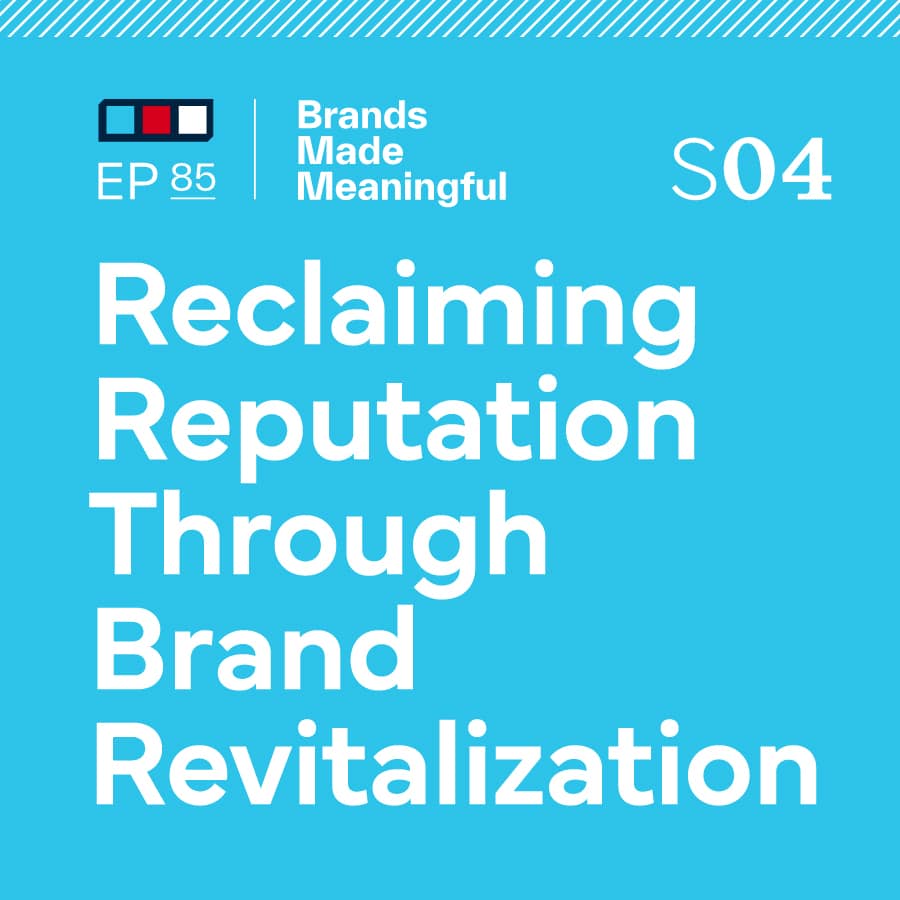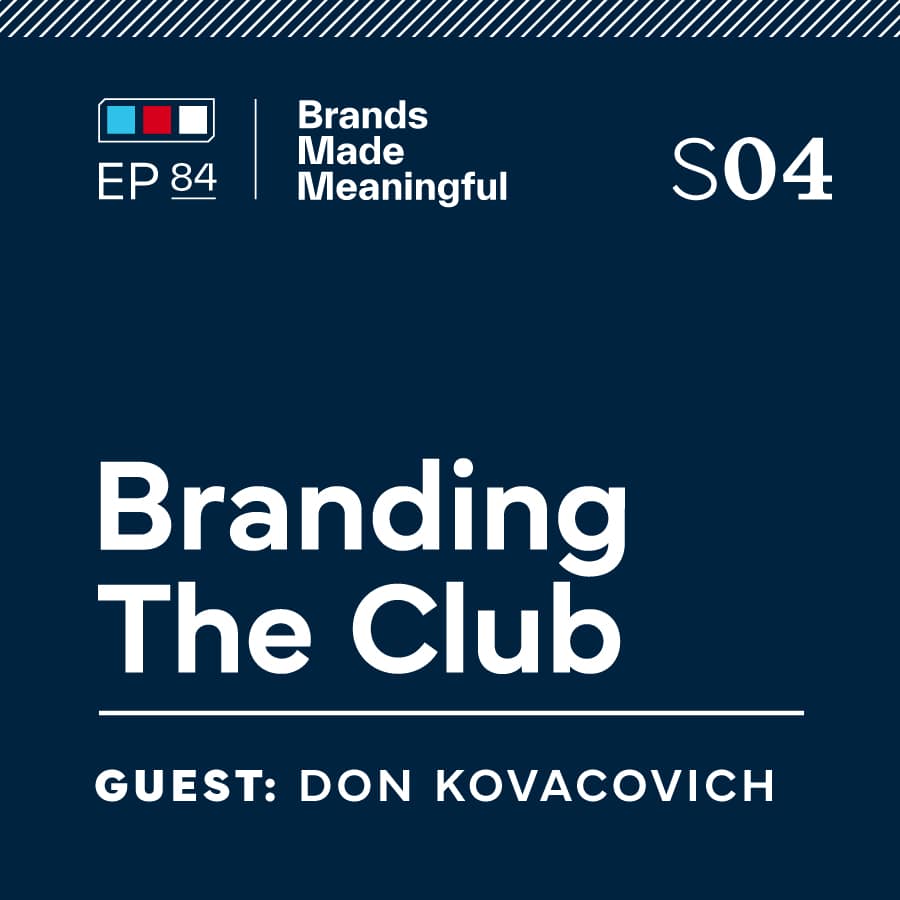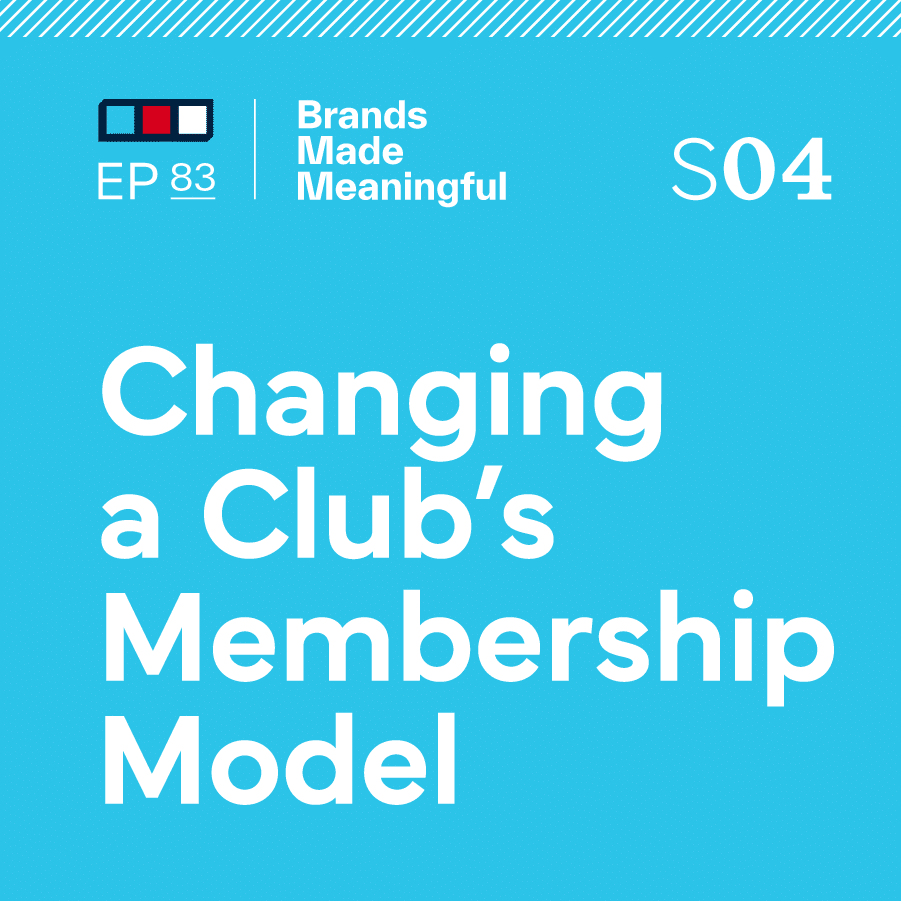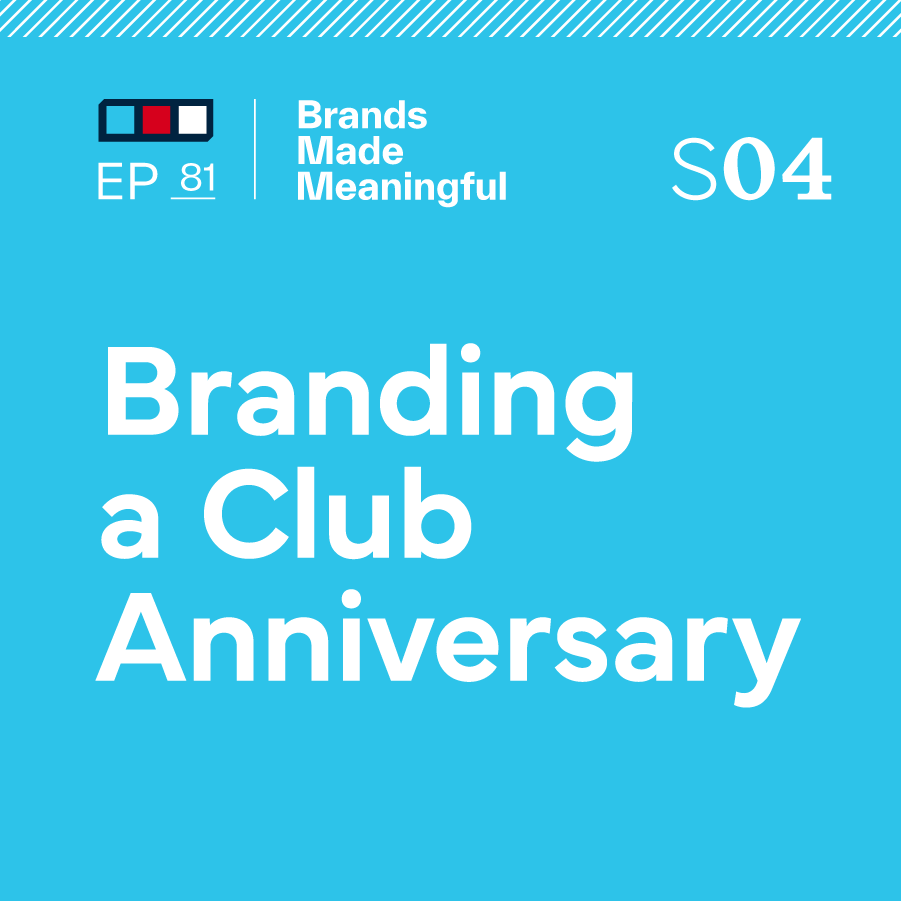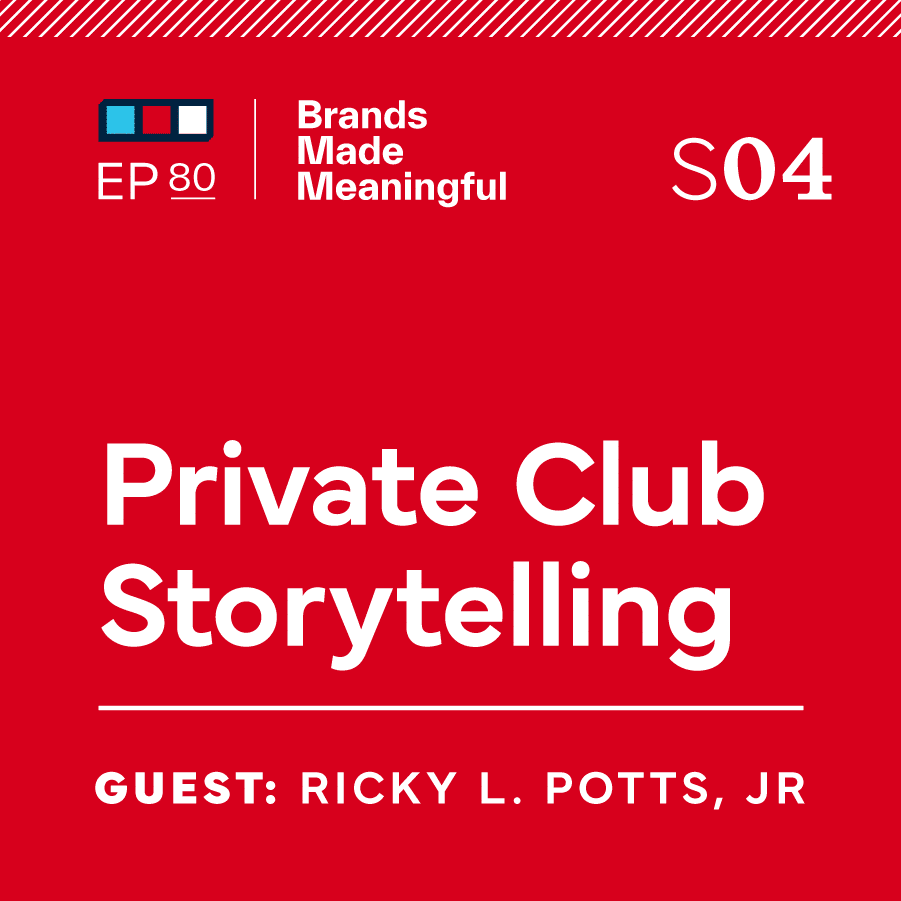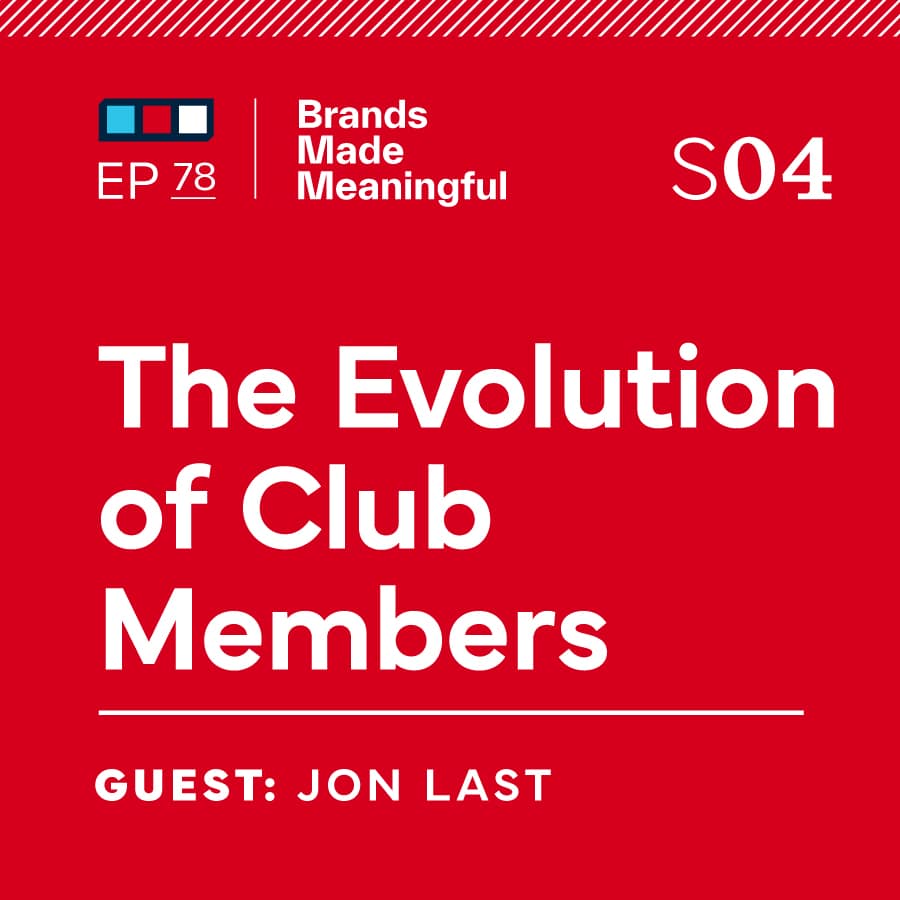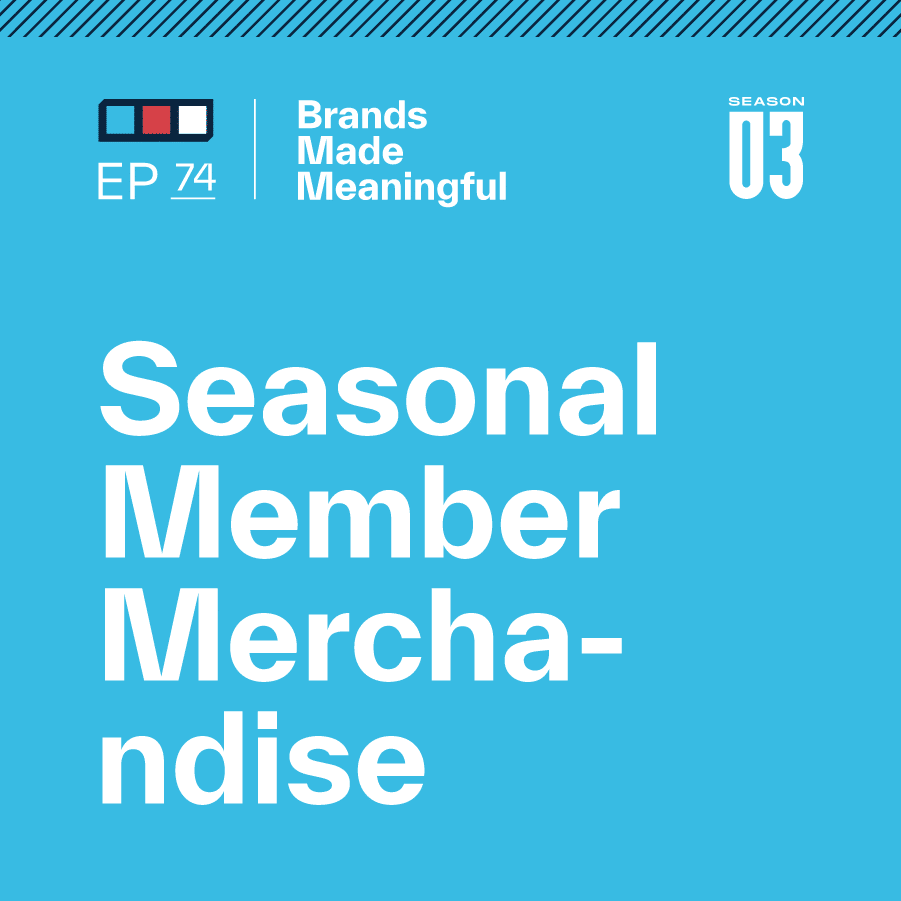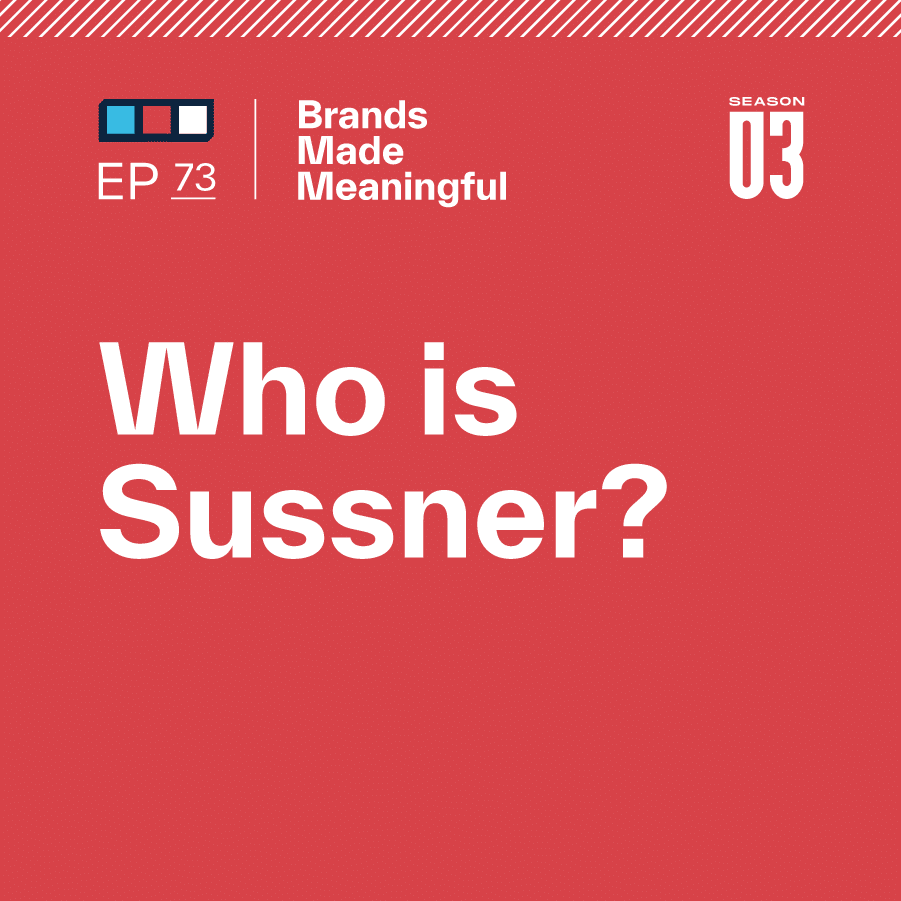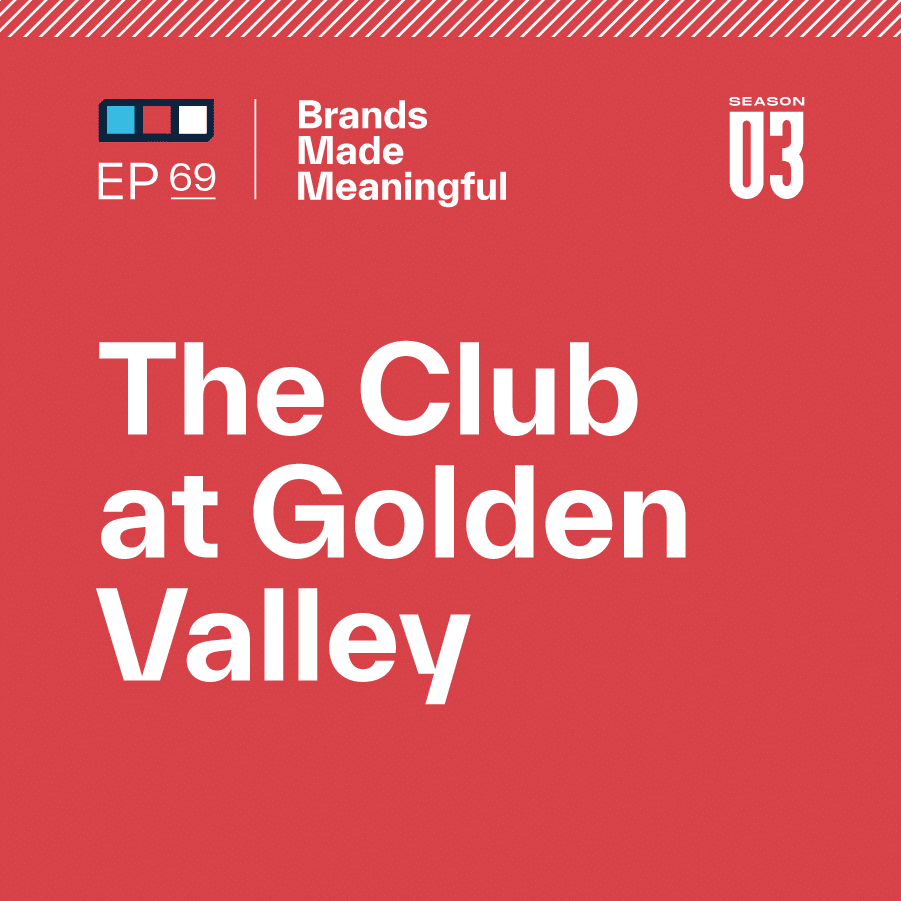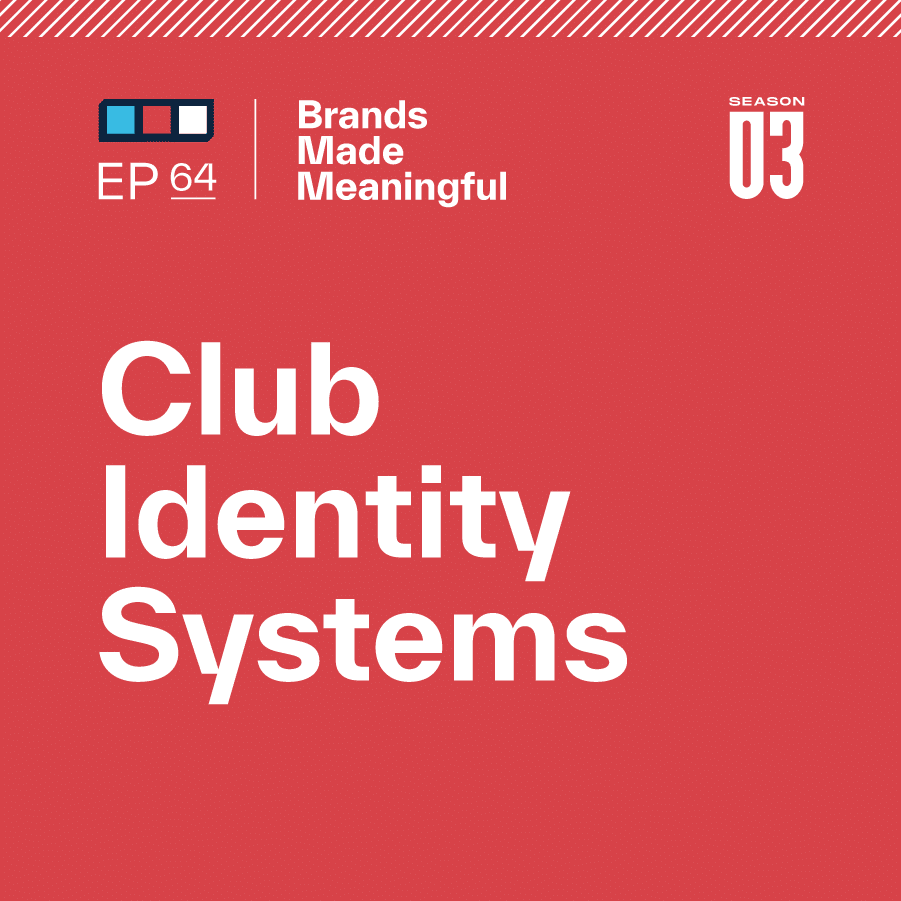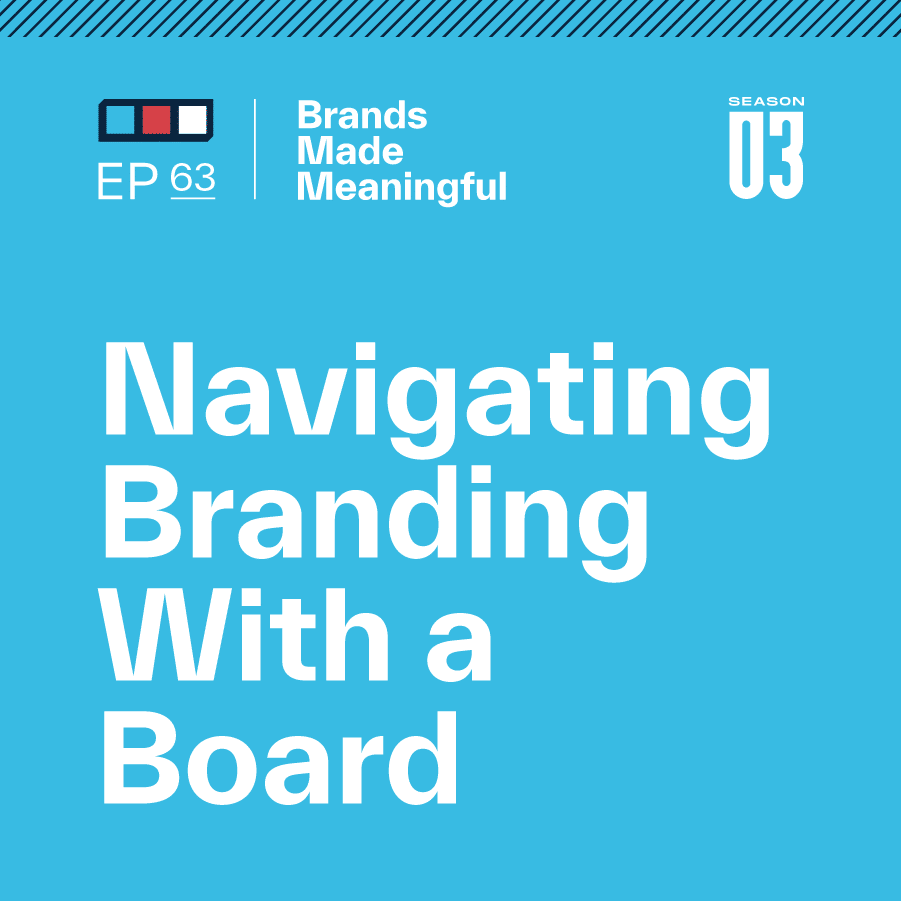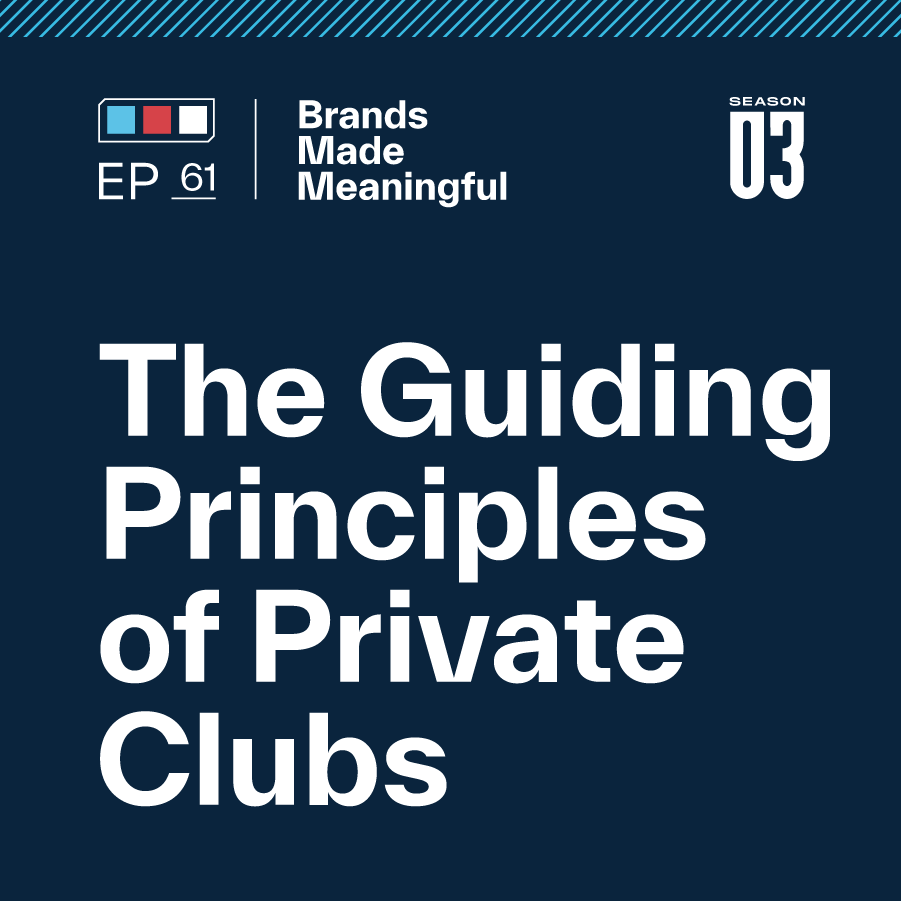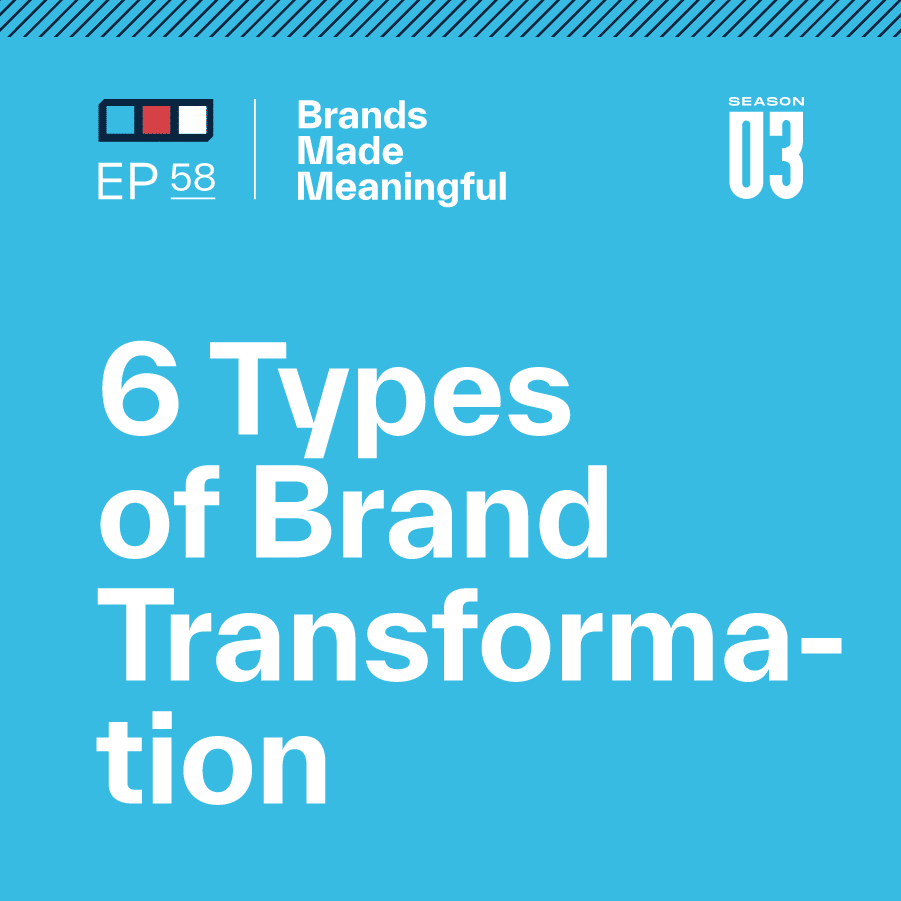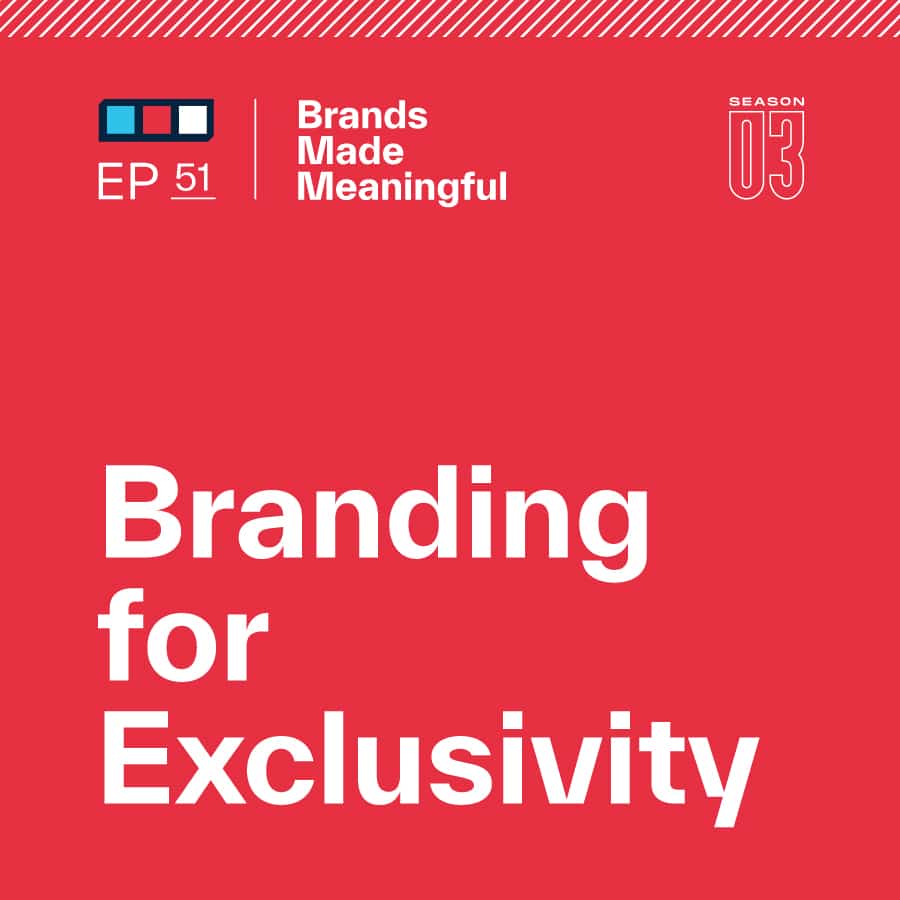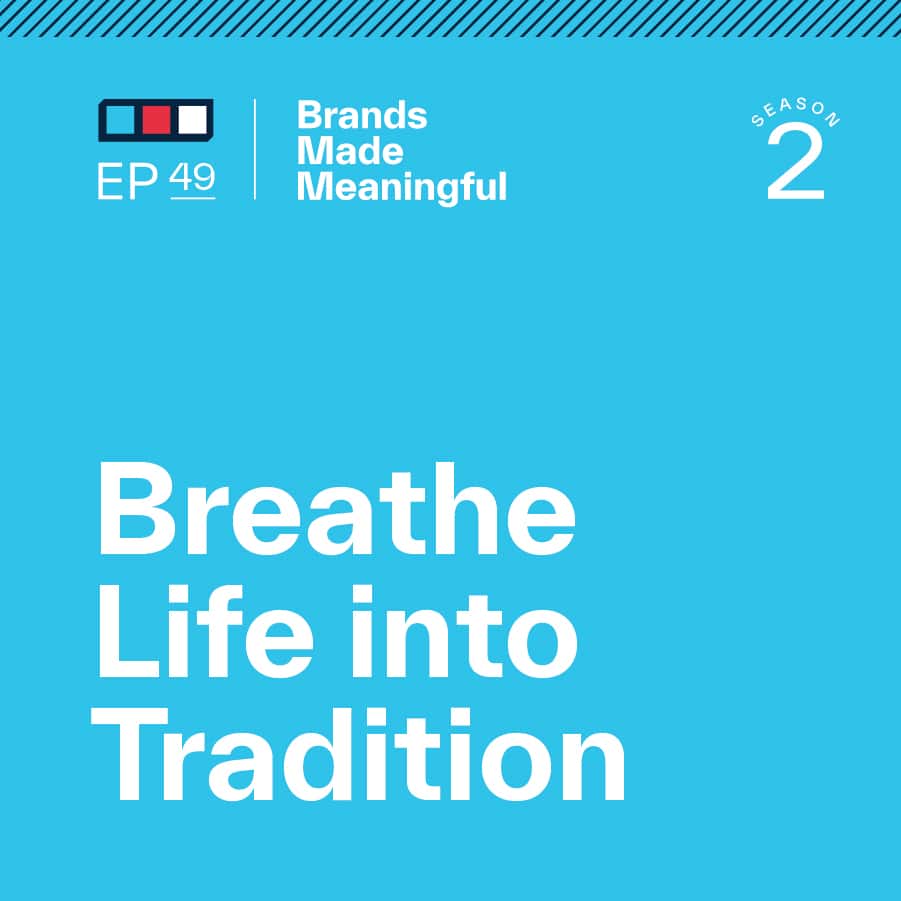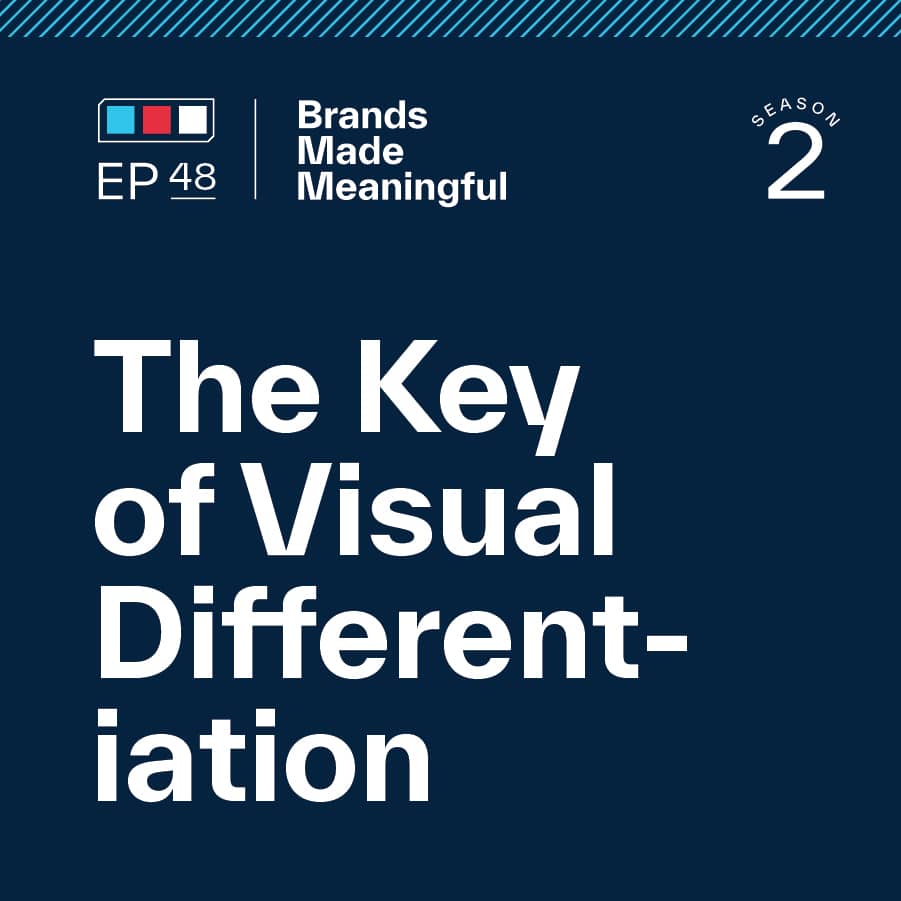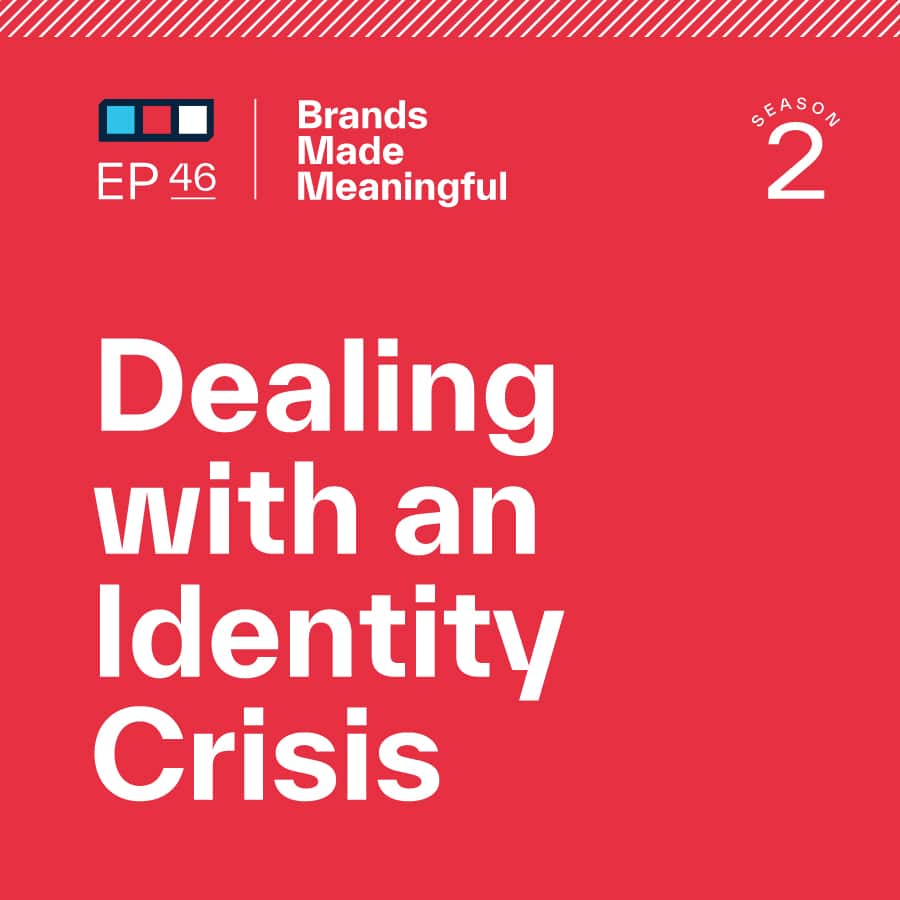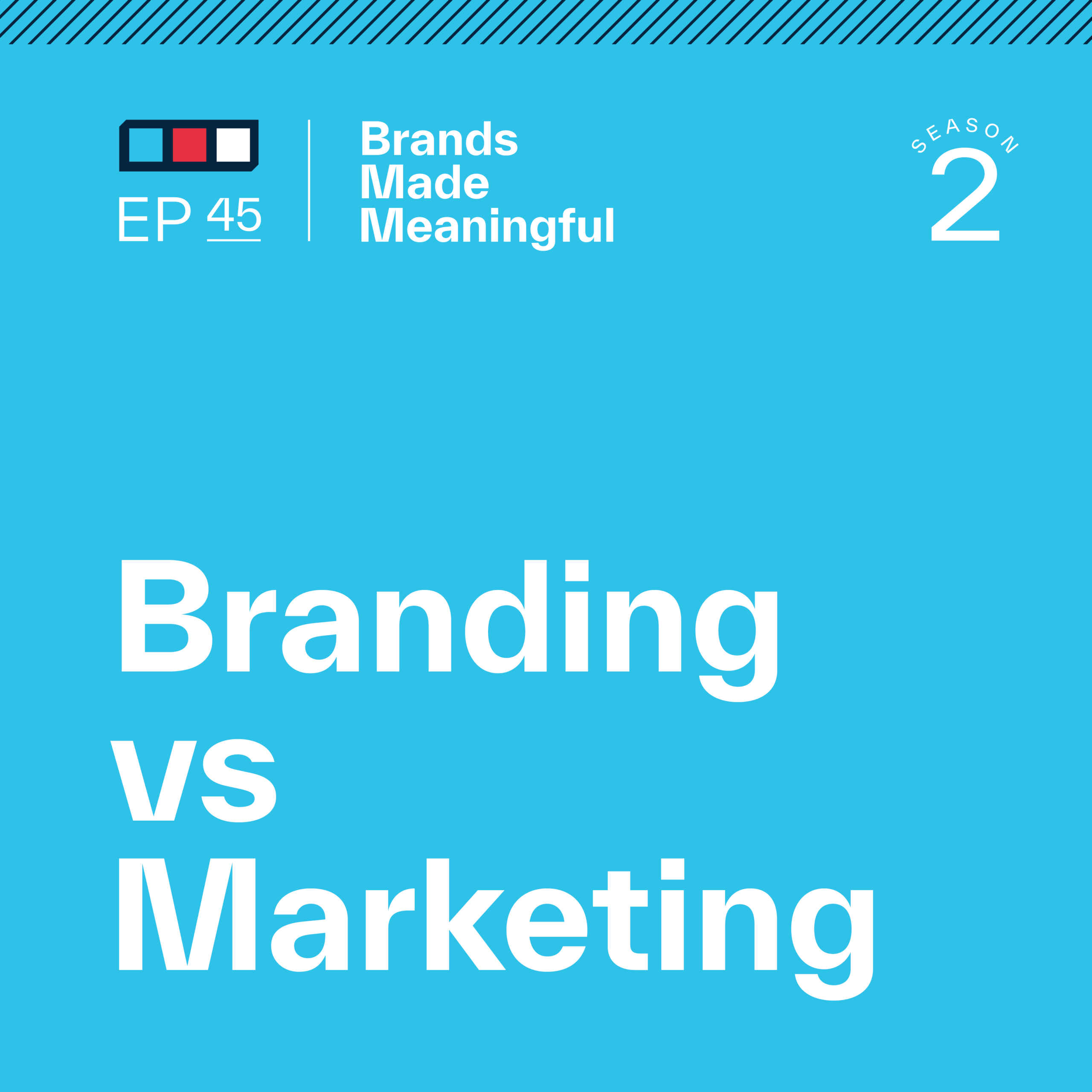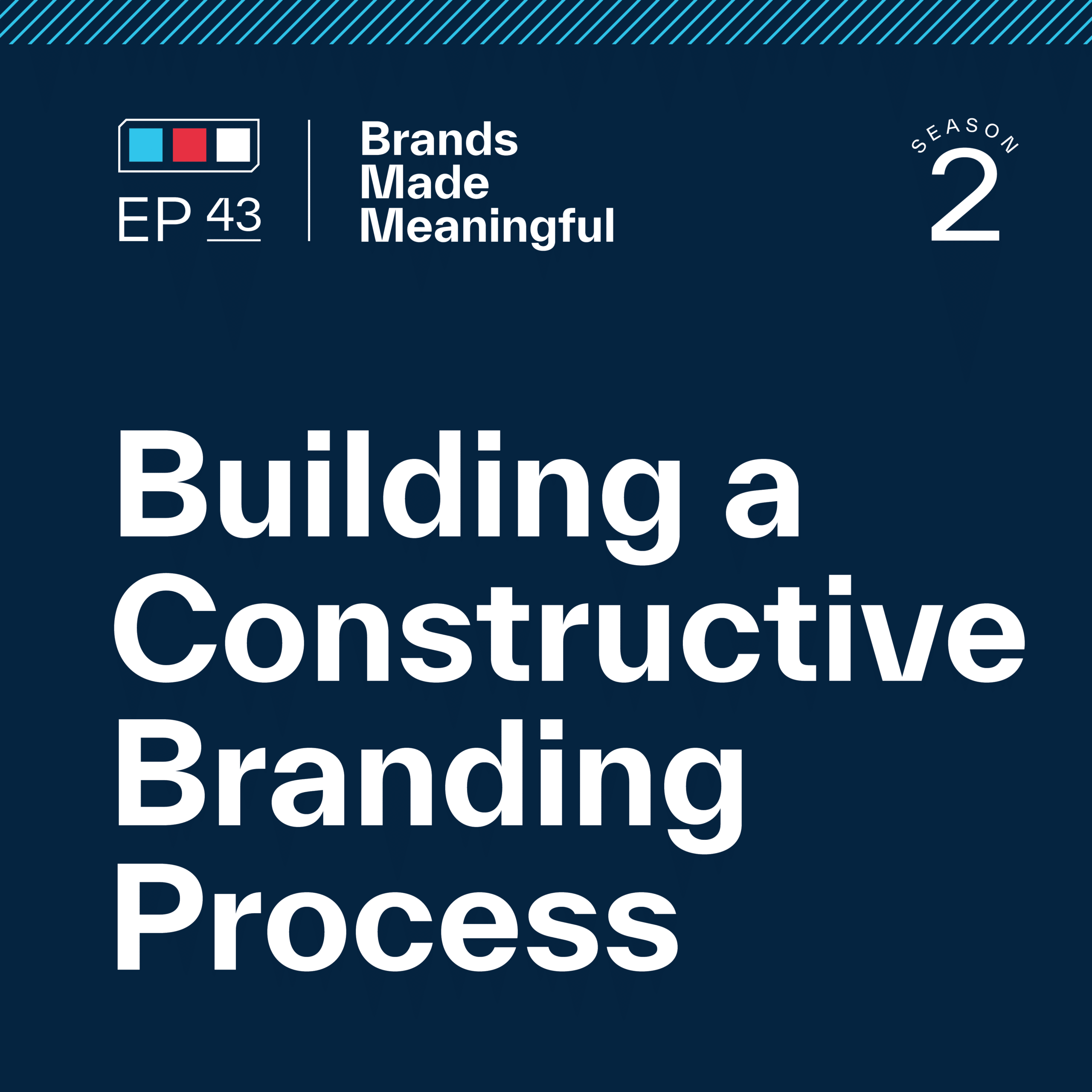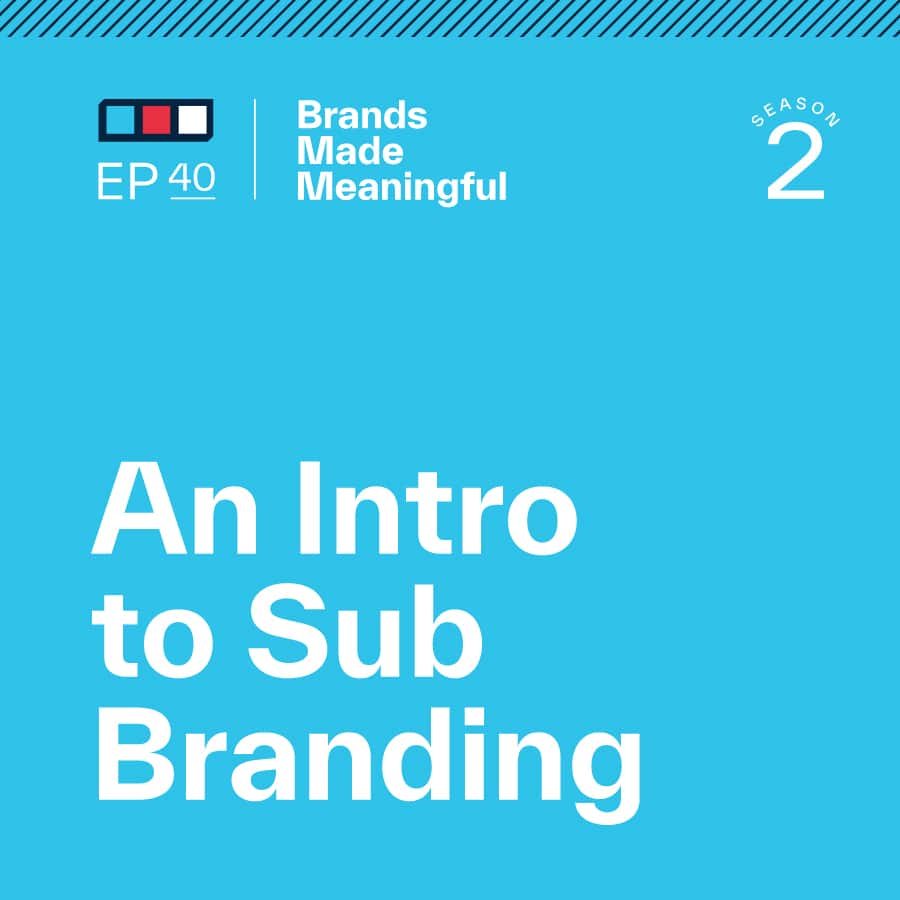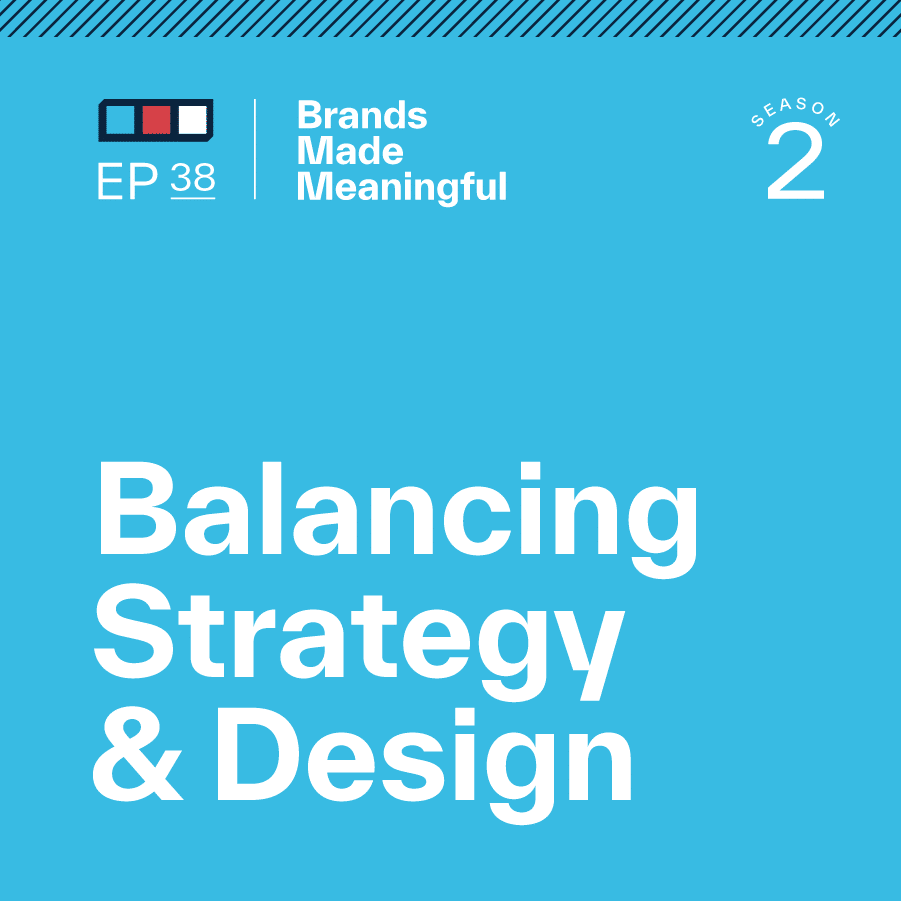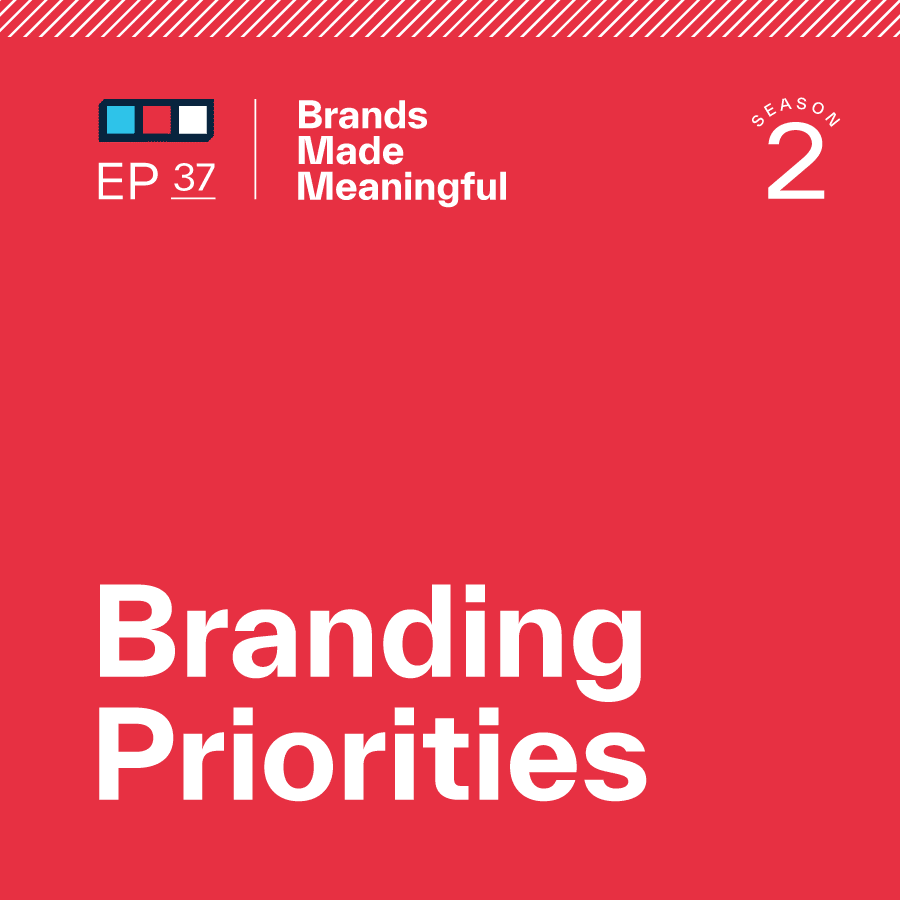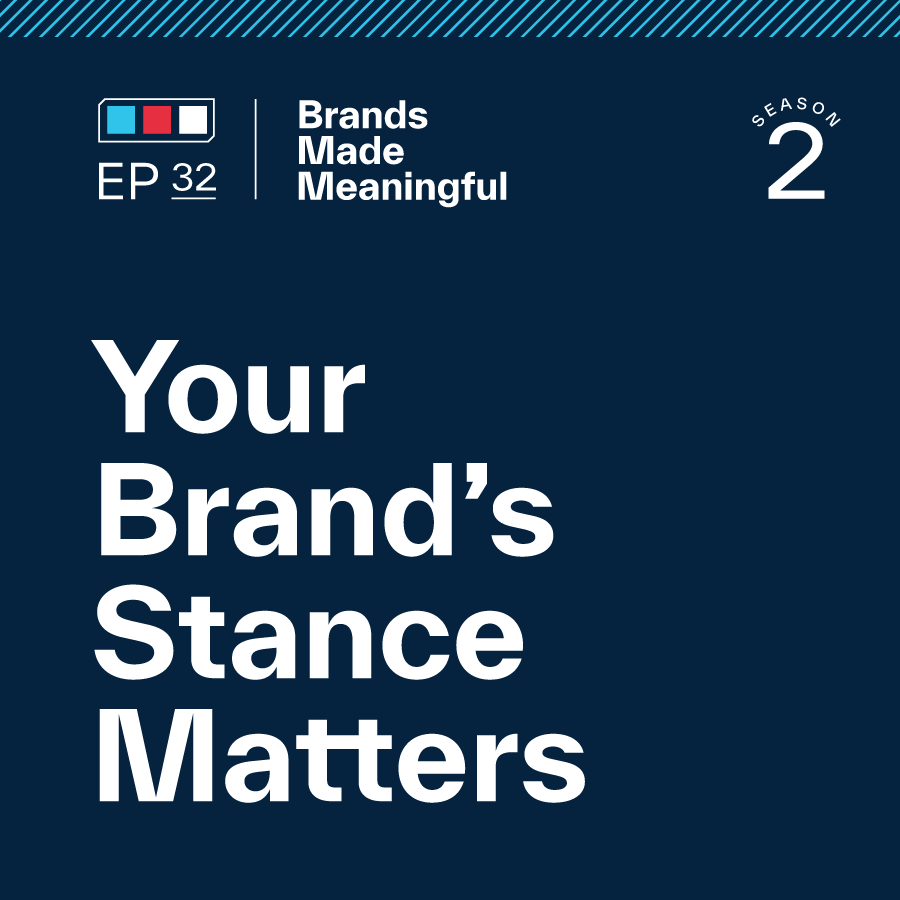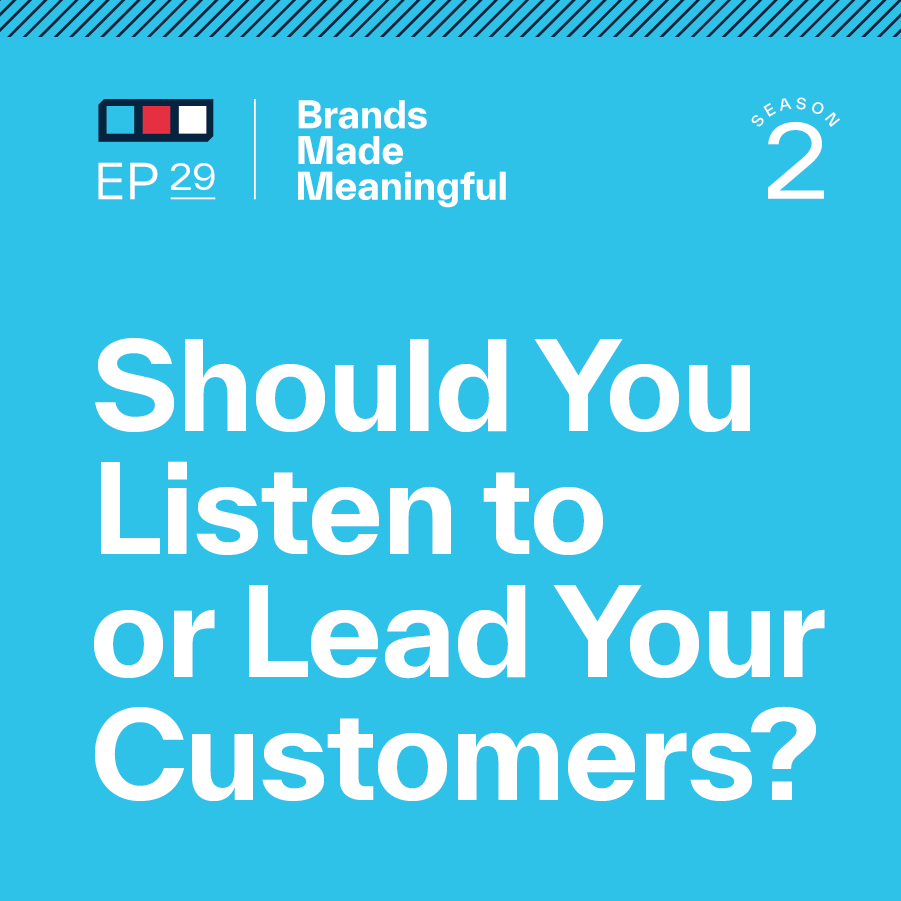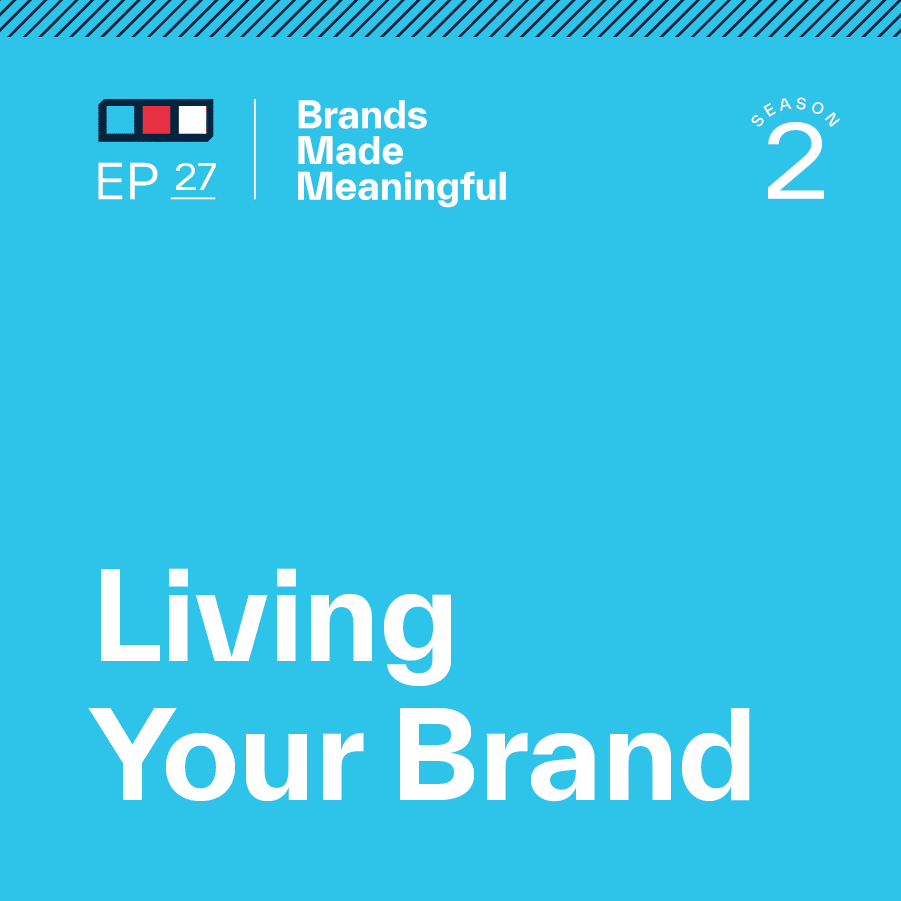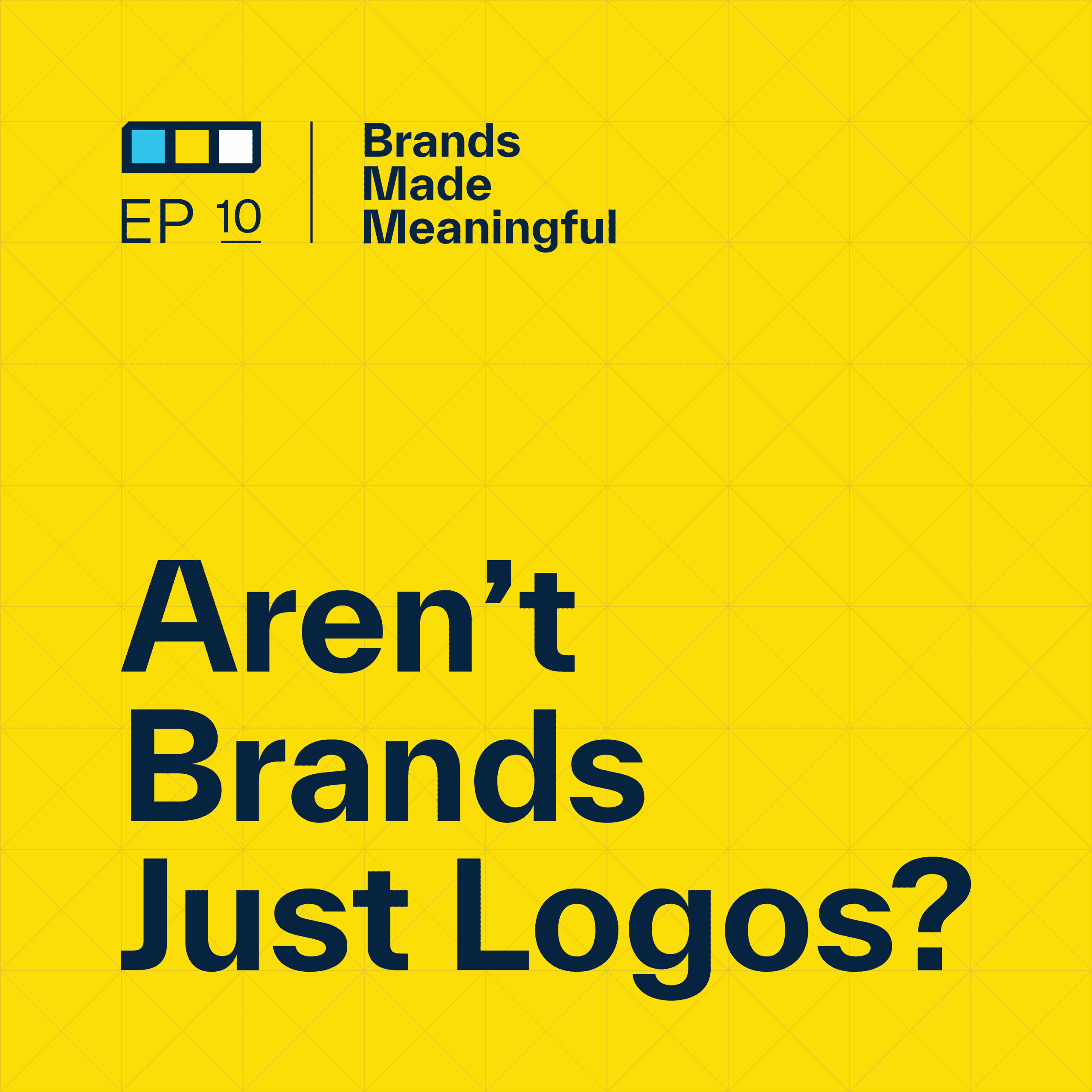EPISODE 52

Measuring Brand Success
Episode 52
Derek and Tucker discuss how we measure our success in branding and a few key KPIs that help us understand our impact.
EPISODE TRANSCRIPTION
Today we’re going to talk about how we measure what we do.
Tucker Branding is super squishy. We call it squishy here. It’s very intangible. It’s something that people invest in all the time and it’s really important for business and it’s really important for success within marketing and all these other components. But it’s hard to measure sometimes.
Expand Full Transcript
Derek We don’t have a product on a shelf to buy. You can walk into a retail store to pick up a new box of golf balls. You can grab them, touch them, look at them, and walk away with them. But when you hire somebody to help you with branding, that brand and that work hasn’t been done yet. That hasn’t been created yet for you. So you’re taking a little bit of a leap of faith that that partner is going to get you there.
Tucker We don’t normally have a problem with clients or prospective clients not understanding the value of what we do. That’s not generally what this conversation is going to be about. But they do find interest in how we choose to measure the success of what we do for the long term.
Derek One of the first things we ask when we start working with somebody is, what does success look like to you? If we’re doing our job right, if we’re doing right by you, let’s put a couple of measurables out there so that when we’re done and we look back, we know that we agree what that success, what that finish line looks like.
Tucker And we’ve had clients go back and they go, Is this just for your case study at the end? And we do use it in case studies – just fair warning. But I think that most of this comes back to what we do needs to have some accountability to it. And if we don’t do it with accountability, then there are no checks and balances for our team to make sure that we’re doing it right.
Derek Our goal is to provide incredible impact with the work that we do. This is the proof of that impact.
Tucker So what I want to do is just run through like super high level. I pulled some KPIs or some metrics.
Derek What are KPIs?
Tucker Key performance indicators from projects that we’ve just done over the last couple of months. So, people who this is a completely new topic for you, you have at least some form of, Oh, he’s talking about that. That makes more sense. So when we deal with customers or fans of brands, this could be something like your Net Promoter Score. That’s a really common one that we use. Think about social media engagement metrics such as likes, comments, and shares. That could be a way that we can measure this – attendance at events or activations that we can do, frequency of repeat purchases, maybe there are customer retention rates we can focus on the before and afters. Even like recognition, we can figure out through surveying and other data collection how recognizable something might be, whether it’s brand or packaging or things like that. I like the idea of thinking that design or creative awards is a metric that can be measured of success on how good or how bad something is. That’s not always the case, but sometimes it’s a good measurement. But maybe for employees, we use these metrics similarly. We’ve used Net Promoter Score for our employees all the time. Do you like working here? Would you suggest working here?
Derek Employee satisfaction type surveys.
Tucker Satisfaction rates and retention rates for employees are really important. Referrals. How many referrals have we gotten or is that increasing? Is it decreasing? So those metrics are interesting. And then we deal with sponsorships a lot. Just talking about sponsorships, whether it’s one of our clients sponsoring, or maybe our client is having sponsors. How does that work? And what is the ROI on some of those sponsorships? What is the brand visibility? Does our reach expand and how many eyeballs have we had on certain activations? So these are like hard-working metrics and I want to put these on the table at the beginning of the conversation because I don’t want to talk about them moving forward. But those are what we’re talking about when I say, How do we measure brand success? It’s with any of those, and then there’s a whole bunch of other ones behind the scenes. They’re customized for what project we’re working on and what we can measure because every client is different.
Derek And the one additional one that most customers that we’re talking with are looking at is financial metrics. They say our sales went up, we sold more, we successfully got into a new market, etc. So there’s a financial impact that’s obviously part of this, too.
Tucker Absolutely. So why do we do this? Why do we measure? Why do we care about measuring success? We kind of got into it a little bit at the front to say it’s about accountability. It’s about understanding that it costs a lot to do what we do. You’re going to invest tens of thousands or hundreds of thousands of dollars in your brand. What are you investing that into for certain activations and what are you getting out of that? It’s important for us to feel like we’re doing right by you, that we’re doing right by everybody involved, to make sure that there are objective measurements instead of subjective pieces.
Derek What’s the return on my investment? And we do refer to this as an investment. We refer to any effort, financially or otherwise, that you put into your brand. We see that as an investment, not as a cost. So there is absolutely a return on that investment.
Tucker And I see what is it essential for us to do within the project scope when we’re working with a client. It kind of moves in future-oriented ways and past-oriented ways. So for the past-oriented ways, it’s really important to understand what we have done, whether it has been successful, and how it has been successful. And that’s a really good thing to understand. But future-oriented ways are to say how we have more informed decision-making when we’re talking about the strategy we’re taking within a brand project or initiative. Or maybe how are we approaching the execution of this project? Is that change based on an informed decision? So it’s like, how do we be smarter? That is kind of how I start looking at it. How we understand what we’ve done and if it’s been successful is a really good way. But I like to think of metrics as helping us get smarter moving forward.
Derek Yeah, but like you said, you get smarter by learning from what was done before.
Tucker The past.
Derek What worked, what didn’t, why didn’t it work, or why did it work? Let’s let’s hone in on that so that now we’re even raising the bar as we go forward.
Tucker Some of the big categories that I like to look at when we’re talking about metrics and KPIs and how we actually bucket these. In my mind, I bucket them really into three big camps for brand. One would be brand awareness. Think about this as how well our brand is known just generally within a certain audience or maybe in different audiences.
Derek Which is measurable.
Tucker Yep, super measurable. Brand perception – how we are perceived by certain audiences. I think most people go, Well, how do you measure that? And there are interesting ways to measure how people think of you. And understanding that helps to understand if what we’re doing is effective for creating the type of perception we want. Think of branding as crafting a perception. This is a critical point for metrics for me.
Derek Especially when you understand what the current perception is of the organization and how they think of themselves. And the potential fracture or misalignment between how they think their perception or their reputation is versus the results they hear back when you measure that perception by their audience.
Tucker You’re teasing what I want to get to later on in this conversation – that an uninformed gut reaction is most of the time off from what is being portrayed in the audience. The last bucket that I look at is brand loyalty. So think about this as how committed our customers are to us, or how committed our employees are to us, or how committed our sponsors are to us. We can measure it for different audiences all over the place. But those three – awareness, perception, and loyalty – are really where we can start finding blindspots within your brand to go, Wow, we just didn’t know that. We thought we were perceived like this, and we’re just not at all.
Derek We could probably have a conversation on each of those three, and maybe we have in some cases. Brand loyalty is fascinating to me. How do you get people who buy your services or products to not be a one-time buyer or purchaser? How do you get them to buy more often? And even more important, how do you get them to be such a fan of you, your product, your service, or your team that they start selling for you? They start telling their friends, their colleagues, and their tribes, that your service and your brand is the only brand for that group of people. If you can crack that metric, you’re probably crushing it.
Tucker So I look at those three and I see them as being interconnected. Awareness leads to perception. So if people know about you in a certain way, they’re going to perceive you in that certain way. And so that growing awareness, whether good or bad, can change that perception of what you’re doing. So they kind of have a hand-in-hand piece. And then a positive perception – if you have really good perception feedback and it’s like, Wow, we’re doing a great job on this, generally that leads to more brand loyalty feedback. So they’re really connected. We can talk about lagging indicators and leading indicators, but when you’re looking at these, you can’t just say all we care about is brand awareness. Because if you only care about brand awareness, then your perception might be off. And If your perception is off, then your loyalty is off. And if you’re just looking at loyalty, then you don’t understand how much people know of you and how they’re even becoming loyal to you. And so to me, it’s hard to say that we’re going to measure one thing and one thing only.
Derek It’s a great model for people to think about when they’re looking at their KPIs metrics. So again, what is it that they’re going to measure a successful brand initiative against? A before and after of awareness, perception, and loyalty are really helpful components to be thinking about.
Tucker So we use this approach all the time, especially in the first part of our process in discovering what the challenge is. We do that a lot. We talked about measuring brand success and that’s great, but there’s also measuring the current brand’s success. So doing this at the front end of our projects generally helps us understand if the initiative that we’ve set out on is successful. So we do it at the beginning and we do it at the end. My favorite, if we’re going to do anything, is figuring out someone’s Net Promoter Score within a certain audience. That is absolutely the first thing that I would say is a really helpful piece. A Net Promoter Score, for those who don’t know, measures how likely someone is to recommend your brand or your offering to another person. So you talk about loyalty. That’s a big part of that, but it breaks it into groups to understand who is what. And then how we understand that individual, whether they’re a promoter or detractor or they’re neutral, that has been really successful. When we work with clubs, when we work with organizations, and when we work with professional sports organizations, it’s just really helpful to get a benchmark for where we are today.
Derek And those are two different audiences too. And the Net Promoter Score works on both. For clubs where you’re probably talking about members and gauging, are our members promoters of our club and our brand and our story and our message or are they telling the wrong story, or are they detracting and damaging who we are in our brand perception awareness for our sports teams? We’re talking about fans or sponsors or partners.
Tucker I try to get every one of our clients to understand the importance of their employee base, especially with how important it is to retain talent and keep that thriving. That Net Promoter Score, from an employee standpoint, can help you understand which employees you need to be leaning into. How can I make my promoters more happy about what’s going on because they’re going to help me spread the word about working here? And then from a detractor standpoint, how can I make them happier? What am I doing right now that makes them not interested in sharing this with their friends and getting more people like them on our team? So anyway, the high level of what I want to go into next is around why. Why does this matter? And you touched on it earlier to say it’s making the subjective decisions easier to not be subjective. A lot of people say, Well, my gut tells me this, and that’s a great way to do it. And there’s a lot of power in making decisions with your gut. But we’ve seen it time and time again where someone might say, I think we are seen like this, but we’re just not when it comes to actually asking people.
Derek The steps in branding in the conversation that we’re having can get, as you said at the beginning, gray and squishy. What that means is there’s a whole undertone of subjectivity, of personal preference, of like/dislike, of I’m attracted to that but my gut says this. That’s inherent in the process. And so what we’re trying to do is gather the insights that add objectives to the whole thing. It helps you make decisions. It helps you feel informed. It helps you not just guess.
Tucker Think about who you are as a marketing leader. You are a leader within your space. You have some biases, right? When you move through a project, you might be one of the three audiences your brand is for. Maybe you work for a professional sports team and you’re a certain type of fan yourself. Well, that makes you biased towards what that type of fan might think versus what the other ones might think. Or maybe you own a sporting goods company and you use the product yourself and you’re the type of audience that might believe this way, but your product isn’t just for you. It’s hard to break yourself away from that and believe that you might be perceived or you might have different loyalties in a different realm than what you personally believe.
Derek It helps us too. We’ll come into a club conversation and we’ll start talking about their existing brand or what they’re thinking. And because you and I play golf, we inherently, without you even being aware of it or thinking about it, automatically have an opinion. You go into your own individual Derek-as-a-golfer role and judge what it is that you see but without any of the objective guidelines to know what the question was that they were going to ask.
Tucker And I think that it’s even more difficult for us because we need that data to keep ourselves true because not only do you have the personal biases that you’re talking about, which we try to stay away from as much as possible, but then you have the biases from other projects you’ve worked with within that same industry to say, Well, we knew this at the time, but as you know, industries change, audiences change, things change so quickly that we could have done a project within the same industry with a similar challenge three or four years beforehand that has a completely different viewpoint on it because that market has now changed.
Derek And those KPIs have changed. The KPIs of organizations before COVID are different for many organizations post-COVID. Nobody saw that coming. The trends and the wants of the up-and-coming generations are always an ever green, changing, and evolving landscape.
Tucker And that’s what gets our team so excited/frustrated. There are people in our office who would say, Well, why can’t we just do this project like we did that project? And unfortunately, everything is so damn custom because things change and every audience is a little bit different and every organization is just a little bit different. But we’re not working with companies or brands that are just selling widgets, and they’re definitely not selling widgets to general people. That’s just not a successful organization that we’ve worked with. So when we talk about why these initiatives need so much upfront work and why everything takes so much longer than people would think – most people would go, Well, why can’t you just design the logo, Derek, I don’t get it. Can’t you just look at it and go boom, it’s this? There’s a lot that goes into it. The reason why there’s a lot that goes into it is because it’s so nuanced and it’s so detailed and specific that you need the data like this to break yourself out of just that internal or previous experience bias.
Derek So what are some red flags, problems, or symptoms that an organization might be experiencing?
Tucker I think my question from this is how would you know if you should be measuring brand success more than you are today? And there are a couple of answers. One is that within projects people are deciding whether or not it’s successful based on whether they like it or not. That is not the way to do it. The way to do it would be to have these metrics, put them in front of the audience in which you are trying to be successful, and say, Do you believe that this is doing what it needs to do? I’m super simplifying that, but that is how I think people can make data-informed decisions on creative things, which is hard most of the time.
Derek So what you’re saying, in other words, is the biggest problem is that most organizations are not measuring any sort of success. There are no metrics or KPIs around whether or not their brand is working other than just their personal I like it or I don’t. I’m happy to wear it on my swag or I’m not. That’s their only litmus test.
Tucker It’s to not have validation metrics. You can’t come back and say, This works for our audience because of these things. And we’ve asked them and they’ve even said, This works. That’s a good validation to come back and go, Look, we’ve achieved what we wanted to achieve. Or if you go way back to what we said and say, Even if you go as a team, we’re making this decision without asking the audience and that’s totally fine. But then you don’t have metrics in place to say a year afterward if that was successful or not. That’s what I’m looking for.
Derek I had a side conversation with a friend of mine and his wife. And I was sharing with them the brand identity of a golf club that we had worked with. The deliverable that she was looking at was the updated logo, and I was sharing with them the before and after of something that had just gone live. And she said, I don’t like it.
Tucker Yeah.
Derek And my response was, That’s totally okay because this brand is not for you. This brand was not created for you. You don’t golf, you don’t live in this area. The type of people that they are trying to attract specifically to their brand are a different demographic and want different things than you do. But in that same conversation if she turned to the person wearing the logo from that golf club and said, I don’t like that golf logo, that person’s feelings may get hurt
Tucker Because it’s personal.
Derek Take that personal preference as that KPI, as that litmus test, without understanding that the person who’s giving that judgment either A doesn’t have all the insights or B isn’t the target market. Frankly, we’re not trying to talk to them. So it’s all back to the way we set this up. It’s being smarter about the feedback and the input that informs the actual information that tells us whether or not this is working the way we want it to.
Tucker Even within the story that you just told, branding is so tricky because it touches so many different pieces and there are so many opinions out there and it’s natural to be subjective about things. You have to be subjective. We can’t be subjective. That’s hard because we’re not preaching to the choir. But every audience member, every fan of a sports team, is subjective. Every member of a private club is subjective in what they do, and they’re subjective because they don’t know that they’re doing it. It’s not it’s not the frontal lobe. You’re not really thinking about every single piece. This is the logo because it’s this. And the color they picked is because of that. It makes total sense. And I love that it’s all tied together and this makes sense. It has to make sense, but it has to be behind the scenes. It has to be immediately recognized. It has to come out. But how we measure that is so challenging.
Derek So let’s go right into that. If an organization recognizes that they don’t have any, or if they have some, of the right systems or metrics established to determine whether or not their efforts are successful, what are some tips or ways for somebody to get started? What should they be thinking about doing first?
Tucker Setting clear goals is the number one thing. We are at Podcast Episode 52. If you listen to Episode 51 before this, I bet setting clear goals is probably in at least half of them. Just stop for a second and say, What are we trying to accomplish and what would that mean to us can really be clear about what the goals are for this project. And it helps you to understand, Okay, we could actually measure some of these pieces once we put those goals on a piece of paper somewhere. The second one would be to use a combination of leading and lagging indicators. So leading indicators mean when we see this spike up, that means something’s coming versus when we see this spike up, that means something has already happened. So there is this leading/ lagging. I like to think about using both because it helps you keep an eye on both the past and the future a little bit. Set up some kind of regular reviewing process where you’re adjusting strategies but you’re being transparent about, Okay, we’re going to watch these things. We’re going to be accountable to these metrics. And when it’s not working after three months, then we’re going to change the way we look at this. And this is why. So it’s just kind of marking everything down, being way more transparent about it, and then holding yourself accountable by putting metrics in place that keep you accountable.
Derek Here in our office, we use a scorecard. We’ve adopted a form of EOS. And so people who have a one-year plan and have milestones, quarterly milestones, as an example, break down the certain things that we look at every week, once a week, to say, are those lagging? Are those leading? And what does that mean then for us to say, Okay, what’s working, what’s not working? I think salespeople inherently get this. I mean, salespeople are driven by KPIs. We’re translating.
Tucker People get it. I mean, we’re kind of dumbing it down a little bit. But there is this level of why this is important that probably needs to be said.
Derek It’s because I don’t know anybody who has ever really consistently implemented and followed through on KPIs when it comes to their brand. I think it’s inherent and part of what salespeople and sales organizations do, but not necessarily the marketing department. They’re looking if our sales are going up or are they going down or if our stadium is full or not. Is our membership full, do we have a waiting list? Those are all, frankly, lagging indicators. Those are all the results of what has happened. But it doesn’t tell you if the brand’s role is positively or negatively affecting those results.
Tucker I would recommend that people look at this at least yearly. You talk about professional sports teams looking at it after every season or in the off-season when people haven’t made their judgments about the previous season that’s already happened. But for clubs, it’s doing it by year-end. You do a year-end survey all the time for your membership to say we’re going to ask our audience, we’re going to ask them a bunch of questions. Make a brand portion – it’s not that hard to ask them some questions. How do you believe we’re perceived today? What do we need to do? How would you like us to change? I mean, there’s not very difficult questions to throw out there. And you’ll find that you get a lot of really interesting answers. You don’t have to take them all, by the way. You can figure out what people say. And it’s good to know rather than to not know at all. And then when you’re looking at going and evolving something, it makes you just feel like you’ve done the due diligence. It makes you a smarter person when it comes to your brand. To your point, a lot of people just think they intuitively know what it should be, but most of the time that’s not the case.
Derek I’ll know it when I see it.
Tucker Yeah.
Derek It’s back to the gut, the gut reaction. And so all our question is to say let’s put some definition around what that gut reaction or what that gut feeling means and how to make it a more positive one more often.
Tucker I think that we try to romanticize the idea of gut decision-making. It’s like, Oh, it’s my gut. I like that. I like making decisions with my gut. That’s great. But the amount of projects, at least I’ve worked on, where someone’s deciding with their gut, then you step back and go, That doesn’t make any sense at all. And then if you’re not the decision maker, but the decision maker has made it with their gut, you feel like you didn’t get a chance to do the work the right way.
Derek The people who successfully lean on their gut reactions are people who have already established their own KPIs and measuring steps and milestones so that their gut reaction makes sense and then they can trust that reaction. It’s like people that get lucky all the time. Somebody famous said luck is when preparedness meets opportunity. So from the outside point of view, you might just see somebody whose gut reaction is that that’s all they’re judging it by. But if that person and that brand and organization are successful, it’s because their gut reaction is based on all of the objectives that they are using versus the person who sees somebody who’s working and thinks that they’re just judging it on their gut going, Wow, I can do that too because it’s working for them. But you’re not seeing all of the behind-the-scenes prep and strategy work that that person is doing.
Tucker It’s a fair point to say if a brand is successful and they’re making decisions with their gut, it’s probably because they’re not articulating the KPIs that they’re really following, which is super fair. And then I would say a brand that’s not successful in growing and exploring and expanding and someone’s making decisions with their gut is probably the same way, but they’re not articulating all the reasons that they’re measuring, and so they’re not understanding that they’re failing.
Derek Right. It’s like the harder I work and the smarter I am, the more often my gut is right.
Tucker Sure. The harder I work, the luckier I get. It’s kind of the same. Anyway, the takeaway here for me is to remember that metrics are interconnected when you think about what you’re going to measure for brand success. I would take more than one measurement. There’s not just one. The measurement we talked about – Net Promoter Score – I’d start there. It’s a really good one to start with, but I would add a layer on specific things after that so that you understand the way that this kind of trickles up and down within your brand. Understand that KPIs can change. You need to be able to reassess and be critical of yourself and be okay with being wrong. When you have a gut reaction and your gut reaction is wrong, well, thank God that you did measurement because now you know that you were wrong. This isn’t quite right and we can move forward. So I think that being wrong with your gut is not necessarily a bad thing. But to your point, it’s about training that gut to get to the point where you understand by using these tools and then learning from real-world examples. Go find things. Go use this in the real world and figure out what’s right and what’s not right. Go talk to people. I’ve talked to a couple of people at networking events. When you ask how they measure the success within the way they’re activating their brand, the people come up with really creative ways to do it because they have a different audience than you. It makes you change the way you think about things, for sure.
Derek I think it’s great. I’m just going back to what we said before – brand awareness, brand perception, brand loyalty. If you think about the handful of KPIs that you put together, as long as they’re all tied back into helping you quantify in some way, shape, or form and get smarter about those three things, then I think you’re on the right track. Just make sure, like you said, to be willing to set those measurables, those metrics, and then be willing to change them. Because every once in a while we’ve put a metric on our scorecard and after three months realize that whatever we were measuring actually wasn’t important, didn’t matter. And to be willing to just throw that one away because now we’ve changed and focused on what actually is helpful for us.
Tucker So til next time.
Derek Sussner is a branding firm specializing in helping companies make a meaningful mark, guiding marketing leaders who are working to make their brand communicate better, stand out, and engage audiences to grow their business. For more on Sussner, visit Sussner.com.
More Episodes Like This
Reclaiming Reputation Through Brand RevitalizationEpisode 85
Derek and Tucker discuss the potential that a branding initiative can have to restore a club’s reputation.
Branding The Club with Don KovacovichEpisode 84
Don Kovacovich, GM of The Club at Golden Valley, joins Derek & Tucker to discuss the impact that rebranding has had on his club and the opportunity it presents for other clubs
Changing a Club’s Membership ModelEpisode 83
Derek and Tucker discuss key considerations and challenges when changing your club’s membership model.
Connecting a Club with its Story with Jackie CarpenterEpisode 82
Derek and Tucker are joined today by Jackie Carpenter, author of People First.
Branding a Club AnniversaryEpisode 81
Derek and Tucker discuss the unique opportunity presented by milestone and anniversary dates for private clubs.
Private Club Storytelling with Ricky L. Potts, Jr., CCMEpisode 80
Derek and Tucker have the pleasure to speak with Ricky L. Potts Jr. about how powerful storytelling can be for your club members.
Opportunity in Club Facility RenovationEpisode 79
Derek and Tucker discuss pivotal key moments in your legacy and how to transform your story through renovation.
The Evolution of Club Members with Jon LastEpisode 78
Derek and Tucker are joined by Jon Last from Sports & Leisure Research Group to discuss the evolution of club members.
Member Branding vs. Product BrandingEpisode 77
Derek and Tucker discuss the challenges their client's have moved through when approaching differing styles of branding.
The Role of a Private Club's LogoEpisode 76
Derek and Tucker take a look back on private club logos they've designed over the years and explain the strategic reasons behind their choices.
Club Brand GovernanceEpisode 75
Derek and Tucker divulge the steps to evolving your brand while retaining your core values.
Seasonal Member MerchandiseEpisode 74
Derek and Tucker take a look at crafting specific merch to celebrate landmarks and special times of the year.
Who is Sussner?Episode 73
Derek and Tucker take a break from talking shop to talk about who they are and what they stand for.
Club Identities Beyond AmenitiesEpisode 72
Derek and Tucker discuss what it takes to stand out in unique ways for your club.
Little Things Mean EverythingEpisode 71
Derek and Tucker take a look at the often missed and easy to overlook.
Build Flexible Brand SystemsEpisode 70
Derek and Tucker break down the building blocks for long lasting branding.
The Club at Golden ValleyEpisode 69
Derek and Tucker take a close look at one of their recent rebrands.
When to Launch a Club RebrandEpisode 68
Derek and Tucker break down how to find the perfect timing when launching a club rebrand.
Steps to Launching a Club RebrandEpisode 67
Derek and Tucker break down the steps to take and the reasons why you should consider a club rebranding.
Brand Marketing vs. Brand DesignEpisode 66
Derek and Tucker define the line between marketing and design and how they intersect to inform one another.
Building Brand GuidelinesEpisode 65
Derek and Tucker show us how to build infrastructure guidelines to unify your brand experience across the board.
Club Identity SystemsEpisode 64
Derek and Tucker cover what Identity Systems entail and how to discern between internal and external methodologies.
Navigating Branding With a BoardEpisode 63
Derek and Tucker bring clarity to uniting your company under one cohesive vision.
Putting a Committee TogetherEpisode 62
Derek and Tucker assemble your need-to-know facts when putting together your committee.
The Guiding Principles of Private ClubsEpisode 61
Derek and Tucker go over the top ways private clubs can find the balance between pleasing old members while attracting new ones, all while making moves towards the future.
How Color Affects PerceptionEpisode 60
Derek and Tucker cover how to best convey your business with color.
Brand EcosystemsEpisode 59
Derek and Tucker break down how to craft effortless experiences when considering your brand as a whole.
6 Types of Brand TransformationEpisode 58
Derek and Tucker dive into 6 distinct types of transformations for a wide range of brands.
Tournament Branding For ClubsEpisode 57
Derek and Tucker discuss designing and delighting your club members with tailored events.
Brand Promoters & DetractorsEpisode 56
Derek and Tucker discuss how high level promoters increase your NPS and how to turn the tides on your detractors.
The Loudest Voices in the RoomEpisode 55
Derek and Tucker talk about gathering feedback while prioritizing every voice.
Determining A Primary AudienceEpisode 54
Derek and Tucker discuss if and when you should be honing in on your audience vs. casting as wide a net as possible.
Branding For ExclusivityEpisode 53
Derek and Tucker discuss the intricate process of naming your brand.
Measuring Brand SuccessEpisode 52
Derek and Tucker discuss how we measure our success in branding and a few key KPIs that help us understand our impact.
Branding For ExclusivityEpisode 51
Derek and Tucker breakdown how brands can create the perception that they are exclusive and only for a certain type of consumer.
What Makes A Brand SurprisingEpisode 50
Derek and Tucker break down the Sussner formula that we believe leads to a surprising brand.
Breathe Life Into Brand TraditionEpisode 49
Derek and Tucker discuss the intricacies and common pitfalls of branding for Private Golf Clubs.
They Key of Visual DifferentiationEpisode 48
Derek and Tucker break down the importance of differentiating your brand on a visual level.
Branding For Private GolfEpisode 47
Derek and Tucker discuss the intricacies and common pitfalls of branding for Private Golf Clubs.
Dealing With An Identity CrisisEpisode 46
Derek and Tucker breakdown how to identify and remedy a brand's identity crisis throughout thoughtful and intentional brand management.
Branding vs MarketingEpisode 45
Derek and Tucker discuss the differences between Branding and Marketing and how to make the two compliment each other.
Build Your Brand's FoundationEpisode 44
A brand's foundation is a critical element in being successful in the long-term.
Building a Constructive Branding ProcessEpisode 43
Derek and Tucker break down the steps required to build the most constructive and meaningful branding process.
What Makes a Brand Relevant?Episode 42
Relevance is a key piece of a brand's identity for creating clarity and connection.
Your Right to WinEpisode 41
Derek and Tucker discuss the “Right to Win” and the odds of your brand's success within your target market.
An Intro to Sub BrandingEpisode 40
Derek and Tucker discuss the nuances of developing sub-branding and strategies.
Conquer Branding FearsEpisode 39
Derek and Tucker dive into how to overcome the fear of change and the nature of constant refinement of your brand.
Balancing Strategy & DesignEpisode 38
Great strategy is a necessary foundation for great design—and great design brings great strategy to life.
Branding PrioritiesEpisode 37
Branding priorities are the actions and initiatives that shape or enhance a brand's identity, perception, and market position.
Invest in Your BrandEpisode 36
Investing in your brand benefits your company as a competitor in the marketplace, builds trust with customers, increases perception of quality, and drives employee engagement.
Why is Positioning Scary?Episode 35
Narrowing the brand's position is really a strategic decision to focus the brand's offerings, messaging and target audience on a specific niche or segment within the market.
What Are Brand Consultants?Episode 34
Derek and Tucker discuss the importance of hiring expertise with a wider breadth of knowledge than just visuals.
Hire for Brand FitEpisode 33
Hiring people that fit your brand is key in order to maintain brand authenticity, positive culture, and consistent messaging.
Your Brand’s Stance MattersEpisode 32
Your stance can help define your brand from a core level and make branding, hiring, and marketing not only easier, but more meaningful.
Levels of Executing a Brand RefreshEpisode 31
If you have a brand strategy in place, how do you execute it?
The Role of Features & BenefitsEpisode 30
Derek and Tucker discuss the importance of features and benefits within the context of branding, selling, and marketing your products and services.
Should You Listen To or Lead Your Customers?Episode 29
Within the challenge of any rebrand is the challenge of managing customers' perception of change.
Managing a Brand TransformationEpisode 28
Episode 28 discusses the highlights and challenges of rolling out a new brand, both internally and externally.
Living Your BrandEpisode 27
Your brand is not this shiny trophy on the shelf. It is something that you are molding every single day.
What Makes a Brand Authentic?Episode 26
Season 2 starts off with a discussion about building authentic brand experiences, both internally and externally.
Reviewing your Competition's CreativeEpisode 25
Derek and Tucker discuss the process of reviewing your competitors' creative strategy to better position your brand within the market.
Interviewing your Audience for InsightsEpisode 24
This episode details the process and benefits of interviewing your audience as part of the branding process.
Assumption ReversalEpisode 23
Derek and Tucker discuss how we change our thoughts and get into a different mindset to refine and revise our branding.
Developing vs. Amplifying a BrandEpisode 22
Another way to say it is, development is building and crafting your brand story, and amplification is then telling it.
Refreshing a Sporting Goods BrandEpisode 21
This episode shares the steps behind Sussner’s work in refining the Shock Doctor brand.
Defining PerceptionEpisode 20
Derek and Tucker discuss the positive and negative impacts of brand perception.
What is a Brand?Episode 19
Derek and Tucker discuss what defines a brand and what makes them successful.
Branding Golf Courses vs Golf ClubsEpisode 18
Derek and Tucker further hone in on golf course design.
Refreshing a Golf CourseEpisode 17
Derek and Tucker discuss the bar for golf course design – and how to push past it.
Let’s Talk Taglines Episode 16
Derek and Tucker talk taglines in today's episode.
Refreshing an Athletic DepartmentEpisode 15
Derek and Tucker sit down today to discuss what logos mean within branding.
Branding a Club Episode 14
Derek and Tucker discuss how to brainstorm branding a club.
An Intro to Internal Branding Episode 13
Derek and Tucker discuss the power behind internal branding.
The Value of Stereotyping Episode 12
Derek and Tucker sit down today to discuss the meaning of stereotyping within the branding world.
We’re on a Mission Episode 11
This episode digs into the rallying cry for the greatness your team is going to accomplish.
Aren’t Brands Just Logos? Episode 10
Derek and Tucker sit down today to discuss what logos mean within branding.
The Business You Are Really In Episode 09
Derek and Tucker sit down today to discuss how to discover what business you are really in to better understand your mission statement.
Clarity of Vision Episode 08
Derek and Tucker discuss the importance of looking ahead towards the big picture to better hone the purpose behind what we do in the now.
Branding B-2-B Environments Episode 07
Derek and Tucker discuss the Branding of Spaces.
It’s All in the Name Episode 06
Derek and Tucker discuss what a name can say - and not - about your company.
Delving Into Branding Data Episode 05
Derek and Tucker jump into the discovery phase of branding before it hits the drawing board.
Content Made Meaningful Episode 04
Today Derek and Tucker discuss the concepts within content and its common misconceptions such as the phrase "Content is King."
Brand Story vs. Brand Messaging Episode 03
Your story matters.
Visuals That Take The Cake Episode 02
Derek and Tucker sit down to discuss visual impact and what that could mean for your brand.
Are You Different or Distinct? Episode 01
It's not about being the only option, it's about being the right option. Join Derek and Tucker as they discuss Differentiation & Distinction.



